Imagine warm morning light spilling across your kitchen, catching the subtle angles of a textured backsplash. It's not just a wall—it's a surface with depth, movement, and a story. This is the power of a modern herringbone backsplash, a design choice that is rapidly defining the look and feel of 2025's most thoughtful kitchens. For years, designers and homeowners have loved this pattern for its ability to feel both classic and completely new.
The Modern Herringbone Backsplash for 2025
The modern herringbone backsplash trend for 2025 is defined by the fusion of its classic, dynamic pattern with new materials, textures, and thoughtful color choices. Key elements include matte-finish ceramics, eco-friendly recycled glass, natural stones like marble and zellige, and dramatic grout lines that either create bold contrast or a soft, tonal look.
This pattern's resurgence isn't an accident. It solves a common design dilemma: how to add visual interest and a touch of luxury without overwhelming a space. Yet, with so many options, it's easy to feel lost. You might wonder which material is right for your lifestyle, what color won't look dated in a few years, or if the pattern will even work in your kitchen's layout.
This guide is designed to be your source of truth. We've curated the most important trends, practical advice, and visual inspiration to help you move from idea to action. Let’s explore the modern herringbone backsplash ideas reshaping kitchens in 2025.
Why Herringbone is the 2025 Kitchen Pattern to Watch
The Question:
Struggling to find a pattern that feels both timelessly classic and refreshingly modern?
The Promise:
This section reveals why the herringbone pattern perfectly bridges that gap, making it the top choice for designers in 2025.
The herringbone pattern has deep historical roots, tracing back to textiles and Roman road paving. This long history gives it an enduring, classic quality. Yet, when applied to a kitchen backsplash with modern materials and colors, it feels entirely current. It’s this unique duality that designers and homeowners are falling for.
In our experience, clients often want something more dynamic than standard subway tile but are cautious of overly trendy patterns that might age poorly. Herringbone is the perfect solution. Its zig-zag structure creates a sense of movement and energy that draws the eye, making it a natural focal point.
According to a recent Pinterest trend report, searches for "herringbone backsplash" have increased by 60% over the last year, signaling a major shift in homeowner interest. This isn’t just for grand, sprawling kitchens. The pattern’s diagonal lines can cleverly trick the eye, making smaller kitchens feel wider or taller, depending on the tile's orientation.
Imagine a sleek Scandinavian kitchen with matte white herringbone tiles, light oak cabinets, and matte black hardware. The pattern adds texture and sophistication without disrupting the minimalist aesthetic. It’s a testament to herringbone's incredible versatility.

Material Trends: From Natural Stone to Eco-Friendly Tile
The Question:
Feeling overwhelmed by the sheer number of material choices, from classic marble to new recycled options?
The Promise:
We’ll break down the top materials for 2025, focusing on their aesthetic, durability, and a growing emphasis on sustainability.
The material you choose is just as important as the pattern itself. For 2025, the trend is moving toward materials with texture, authenticity, and a conscience.
Top Material Choices for 2025
- Zellige Tile: Handmade Moroccan clay tiles are celebrated for their imperfections. Each tile has slight variations in color and texture, creating a surface that feels organic and full of character.
- Marble: Always a classic, marble brings undeniable luxury. Calacatta and Carrara marble herringbone backsplashes continue to be popular, but require sealing and more careful maintenance to prevent stains.
- Porcelain & Ceramic: These are the workhorses of the tile world. Modern manufacturing allows for porcelain tiles that convincingly mimic natural stone or concrete but offer superior durability and are virtually maintenance-free.
- Recycled Glass: As sustainability becomes a bigger factor in design choices, recycled glass is a beautiful and responsible option. It reflects light beautifully, making a kitchen feel brighter, and many brands now offer tiles with up to 80% post-consumer recycled content.
A common misconception is that eco-friendly materials are less durable. In reality, modern recycled glass and composite tiles are engineered to withstand the heat and moisture of a kitchen environment, often outperforming traditional options.
For homeowners looking for an accessible and less permanent solution, the world of peel-and-stick tiles has made incredible leaps. To see just how versatile these budget-friendly materials can be, our guide on 25 Modern Vinyl Backsplash Ideas for Stylish Homes is a fantastic resource for inspiration.

Color Combinations & Grout Choices That Define 2025
The Question:
Does grout color *really* make that much of a difference?
The Promise:
Here, you'll see exactly how the right grout can completely transform your backsplash from a subtle texture to a bold statement piece.
Grout is the unsung hero of tile design. Once a purely functional element, it’s now a key design tool for defining the final look of your herringbone backsplash. Your choice comes down to two main strategies: contrast or cohesion.
Creating Contrast
Pairing a light-colored tile, like classic white ceramic, with a dark gray or black grout creates a dramatic, graphic effect. This approach highlights the intricate "V" shape of the herringbone pattern, turning your backsplash into a bold focal point. This is a signature look in modern farmhouse and industrial-style kitchens.
Achieving Cohesion
For a softer, more serene aesthetic, choose a grout color that closely matches your tile. A sage green tile paired with a sage green grout, for instance, creates a monolithic look. The pattern is still visible through its texture and shadow lines, but it reads as a subtle, elegant surface rather than a busy pattern.
A pro-tip we always share with clients is to pull a grout color from another element in the kitchen. For example, if you have quartz countertops with gray veining, using a similar gray grout for your backsplash will create a sophisticated, unified design palette. To dive deeper into the vast world of tile materials and find the perfect match for your project, our comprehensive What Kitchen Backsplash Tile Guide offers an extensive overview of your options.
Layout Inspiration: Herringbone in Small and Large Kitchens
The Question:
Are you worried that a dynamic pattern like herringbone will overwhelm your small kitchen?
The Promise:
Discover how to correctly scale and orient the pattern to make any kitchen, regardless of size, feel more expansive and beautifully designed.
One of the best qualities of the herringbone pattern is its scalability. It can be adapted to work beautifully in a cozy galley kitchen or across a grand feature wall. The secret is in the tile size and orientation.
Tips for Small Kitchens
In a smaller space, using smaller-format tiles (like 1"x4" or 2"x6") prevents the pattern from feeling too large or busy. A light color palette will also help the space feel open and airy. A common mistake is thinking a pattern will make a small room feel smaller, but herringbone's diagonal lines actually create an illusion of movement and width.
A fantastic trick for smaller kitchens is to run the backsplash all the way up to the ceiling. This vertical application draws the eye upward, making the room feel significantly taller.
Creative Layouts and Accents
You don’t have to commit to an entire wall of herringbone. It works wonderfully as a feature accent. Consider installing a herringbone panel just behind your stove or sink area, framed by a simple tile edge or even just painted wall. This creates a high-impact focal point without the cost or visual weight of a full installation. This strategy is just one of many Trendy Kitchen Wall Ideas 2025 that empower you to personalize your space with maximum impact.

Step-by-Step: How to Install a Herringbone Backsplash
The Question:
Are you tempted to tackle this as a DIY project but feel intimidated by the angles and cuts?
The Promise:
This guide breaks down the installation process into clear, manageable steps, empowering you to achieve a professional-looking result.
Installing a herringbone backsplash requires more precision than a standard subway tile layout, but it's a project that a patient DIYer can certainly accomplish. Planning is absolutely essential.
Step 1: Preparation is Everything
Before a single tile goes on the wall, ensure your surface is clean, dry, and perfectly smooth. Patch any holes and sand them down. A pristine canvas is crucial for good adhesion. Measure the area you plan to tile and calculate your square footage to purchase the right amount of tile (always add 10-15% for cuts and mistakes).
Step 2: Finding Your Centerline
Unlike other patterns, you don't start in a corner. For a herringbone layout, you must find the exact vertical center of your wall. Use a level to draw a perfectly straight plumb line from the countertop to the cabinets. This line will be the guide for the points of your "V" shapes, ensuring the pattern is balanced.
Step 3: Cutting and Setting the Tiles
This is where it gets tricky. You'll need a wet saw with a good diamond blade to make the angled cuts required where the pattern meets the countertop and cabinets. Start by applying a thin layer of tile adhesive (thin-set mortar) with a notched trowel. Set your first tiles along the centerline, working your way outwards. Use tile spacers to maintain consistent grout lines.
Step 4: Grouting and Finishing
After the adhesive has fully cured (usually 24-48 hours), it's time to grout. Apply the grout with a grout float, pressing it into the gaps at a 45-degree angle. After about 15-30 minutes, use a damp sponge to wipe away the excess grout from the tile surfaces. Once the grout is cured, apply a grout sealer to protect it from stains and moisture.
For those who love the herringbone look but need a simpler and faster installation method, modern peel-and-stick products have revolutionized DIY. For a complete walkthrough of this user-friendly approach, our definitive guide on How to Install Peel and Stick Tiles & Best Designs 2025 is the best resource available.
Style Pairings: Countertops, Cabinets & Fixtures
The Question:
How do you ensure your beautiful new backsplash harmonizes with your cabinets, countertops, and hardware?
The Promise:
We’ll share foolproof combinations and designer principles for creating a cohesive and stunning kitchen environment.
A backsplash doesn't exist in a vacuum. Its success depends on how well it complements the other major elements in your kitchen. The key is to balance texture, color, and finish.
Countertops and Cabinets
If you choose a visually active backsplash like a veined marble herringbone, opt for a quieter countertop, such as a solid-colored quartz or soapstone. Conversely, if your backsplash is a subtle, single-color ceramic, you can afford to go with a more dramatic, heavily veined granite or marble countertop.
A classic, high-contrast pairing we're seeing everywhere is warm walnut cabinets with a cool, light-colored marble or porcelain herringbone backsplash. The warmth of the wood provides a beautiful balance to the crisp, clean lines of the tile, creating a look that is both inviting and sophisticated.
Fixtures and Lighting
Your cabinet hardware, faucet, and light fixtures are the jewelry of the kitchen. For a modern look, matte black fixtures create a striking contrast against a light backsplash. For a warmer, more glamorous feel, brushed brass or champagne bronze hardware can pick up on warm tones in wood cabinets or countertop veins.
Finally, don’t forget lighting. Under-cabinet lighting is a must to highlight the texture and intricate pattern of your herringbone backsplash, making it a true feature day and night. Visualizing how different tile patterns interact with these elements is key. For more ideas, our guide on How to Use Trendy Subway Tile Patterns can help you explore different layouts and their effects.

Modern Twists: Mixing Herringbone with Other Tile Patterns
The Question:
Love the look of herringbone but want to create a design that feels completely unique and custom?
The Promise:
Learn the designer's secret to creatively mixing tile patterns for a high-end look without making your kitchen feel chaotic.
For the truly design-adventurous, mixing tile patterns can elevate a kitchen from beautiful to unforgettable. The key to avoiding a "pattern overload" is to establish a clear hierarchy.
A great rule of thumb is the 80/20 principle. Let one pattern be the star (your herringbone) and the other be the supporting act. For example, use a bold herringbone pattern on a feature wall, like the area behind the stove or a kitchen island, and use a simpler, larger-format tile on the surrounding walls.
Another sophisticated approach is to use the same tile but in different patterns. You could have a wall of vertically stacked subway tiles that transitions into a herringbone layout over the sink. This creates a subtle shift in texture and rhythm that feels intentional and custom. Some homeowners even pair herringbone with different materials, like the rustic charm of brick. For visual ideas on combining textures, our article on How to Use Rustic Brick Tile Accents offers great inspiration.
Which herringbone style fits your kitchen?
Maintenance & Long-Term Care for Herringbone Backsplashes
The Question:
Are you worried that a beautiful and intricate backsplash will be difficult to keep clean and looking new?
The Promise:
This section provides simple, practical cleaning routines and long-term care strategies for any backsplash material.
Your kitchen backsplash is a hardworking surface, so choosing a material that fits your lifestyle is important. Luckily, maintaining a herringbone backsplash is straightforward. The primary considerations depend on the material and the grout.
A common myth is that the angles of a herringbone pattern trap more grime. In reality, as long as it's properly sealed, cleaning it is no different than cleaning any other tile layout. A simple spray of a pH-neutral cleaner or a solution of mild dish soap and water is sufficient for daily wipe-downs.
The biggest factor in long-term care is sealing. Natural stone like marble is porous and must be sealed upon installation and typically once a year thereafter. This prevents things like wine, coffee, or oil from penetrating the stone and causing permanent stains. Grout, being cement-based, is also porous and should be sealed to prevent discoloration.
Here’s a quick comparison of maintenance needs for popular materials:
| Material | Daily Cleaning | Sealing Requirement | Long-Term Durability |
|---|---|---|---|
| Marble | pH-neutral cleaner; wipe spills immediately | Annually (stone & grout) | High, but prone to etching/staining |
| Porcelain | Any non-abrasive cleaner | Only the grout needs sealing | Very High; stain & scratch resistant |
| Ceramic | Any non-abrasive cleaner | Only the grout needs sealing | High; durable and easy to maintain |
| Recycled Glass | Any non-abrasive cleaner | Only the grout needs sealing | Very High; non-porous and stain-proof |
Final Thoughts
The herringbone pattern has proven its staying power, gracefully evolving from ancient flooring to the focal point of the modern kitchen. Its enduring appeal lies in its perfect balance of classic structure and dynamic energy. As we look to 2025, the trend is clear: it’s about personalizing this timeless pattern with sustainable materials, thoughtful colors, and creative layouts.
Your kitchen should be a reflection of your taste and a backdrop for your life. A herringbone backsplash offers a unique opportunity to add character, texture, and a touch of art to the heart of your home. Whether you opt for the rustic charm of zellige or the sleek lines of a peel-and-stick alternative, the result is a space that feels both current and timeless.
If this detailed breakdown has you feeling confident, you might be ready for the next step. For an even more in-depth walkthrough, our comprehensive DIY Herringbone Backsplash: Step-by-Step Installation Guide provides everything you need to execute your project flawlessly.
Ready to find your perfect pattern? Explore our full herringbone inspiration gallery for more ideas.
Frequently Asked Questions
What is the best grout color for a white herringbone backsplash?
For a bold, graphic look that emphasizes the pattern, choose a dark gray or black grout. For a softer, more subtle and textural appearance, select a white or very light gray grout that blends in with the tile.
Can I use a herringbone pattern in a very small kitchen?
Absolutely. Using smaller tiles and a light color palette can make a small kitchen feel wider and more dynamic. Extending the backsplash to the ceiling is another designer trick that creates an illusion of height, making the space feel larger.
Are peel-and-stick herringbone tiles a good option?
Yes, they have become an excellent option for budget-conscious homeowners and renters. Modern peel-and-stick tiles offer surprisingly realistic textures and are incredibly easy to install, making them perfect for a quick and impactful DIY update. To see the amazing variety available, check out our guide to Peel Stick Backsplash Kitchen Ideas 2025 for the latest trends.
How is herringbone different from a chevron pattern?
It's a common point of confusion. Herringbone tiles are rectangles laid in a broken zig-zag pattern. Chevron tiles are cut at an angle so they meet at a point, creating a continuous "V" shape. Herringbone has a more complex, interlocking look, while chevron is more uniform.


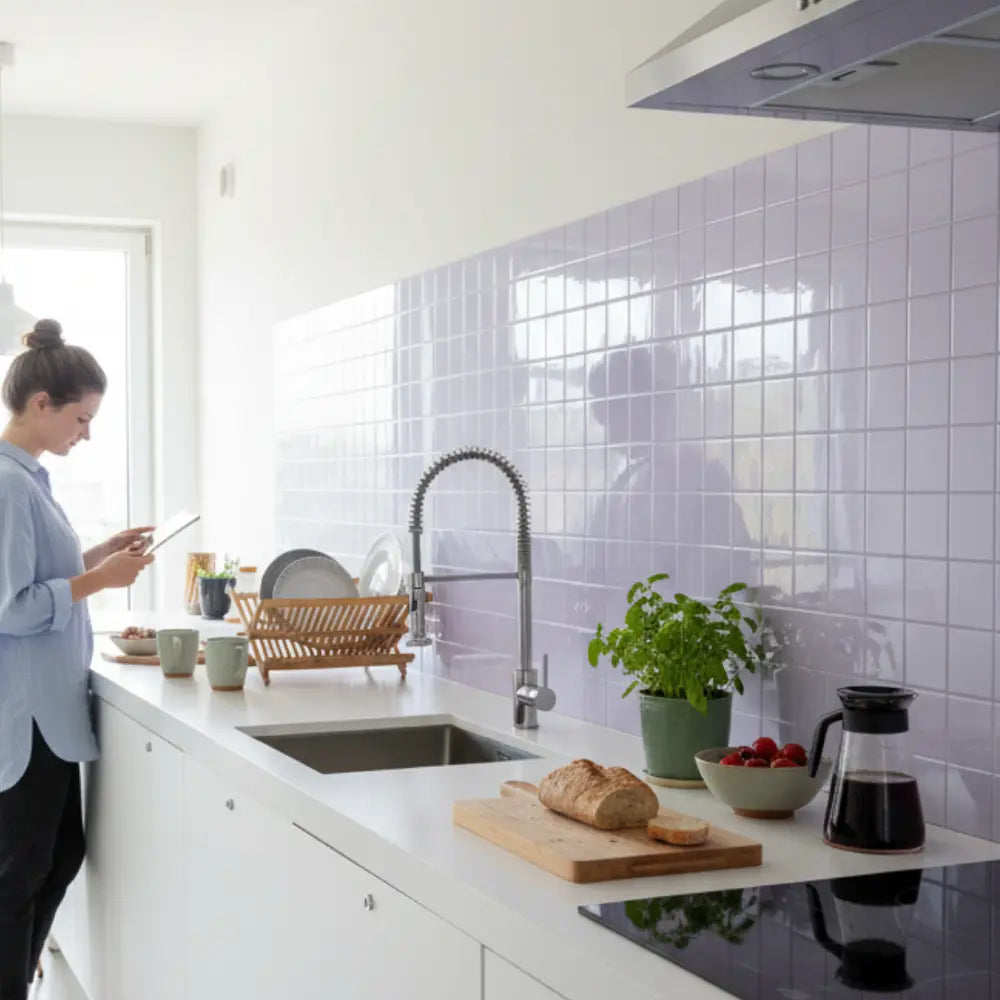
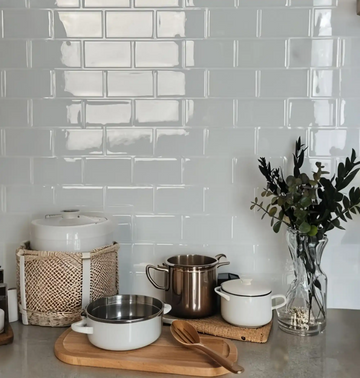
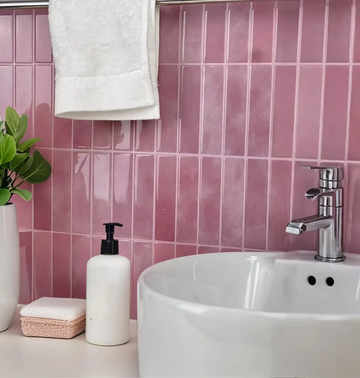
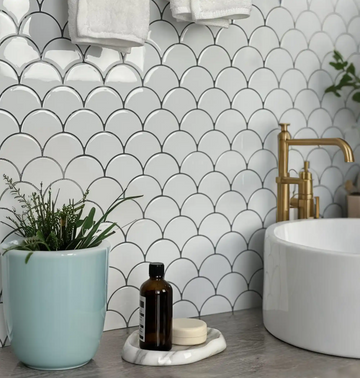
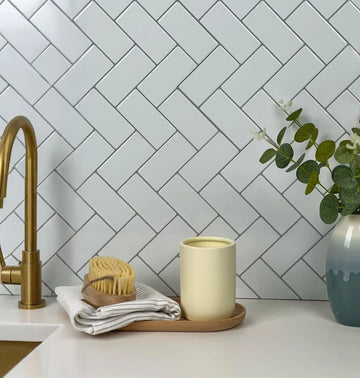



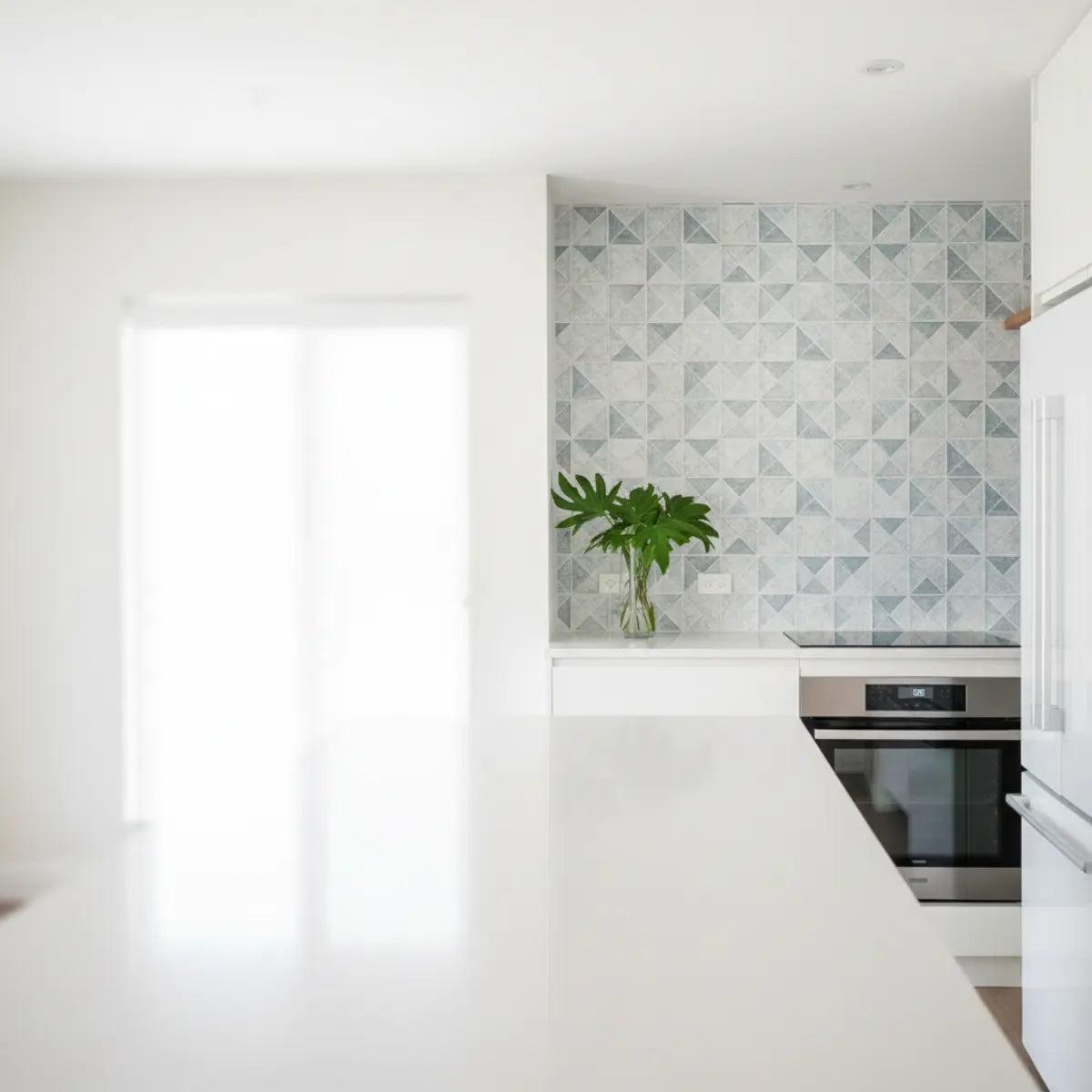

Hinterlasse einen Kommentar
Diese Website ist durch hCaptcha geschützt und es gelten die allgemeinen Geschäftsbedingungen und Datenschutzbestimmungen von hCaptcha.